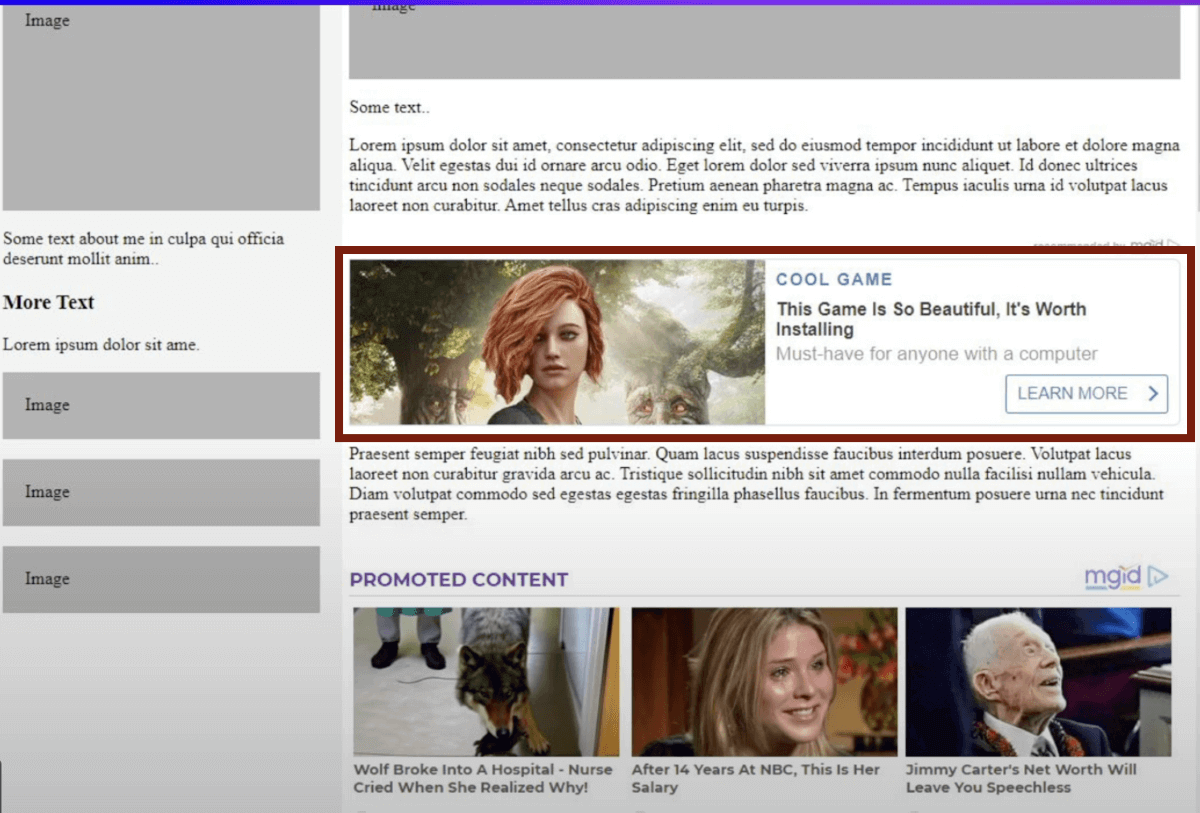MGID Review: How it Works, Benefits, and Best Alternatives

Monetizing a website isn’t just about putting ads on a page and waiting for revenue. Every publisher runs a different setup. Some get most of their traffic from the U.S., others from Southeast Asia. Some publish tech reviews, others run lifestyle blogs or news aggregators. What works well for one site might completely flop on another.
MGID is a well-known native ad network, and for good reason. It offers decent fill rates, especially in non-English markets, and the ads tend to blend into your content rather than interrupt it. For many publishers, it performs reliably.
But not everyone has the same experience. You might be seeing low engagement, irrelevant ads, or just feel like there’s not enough control. And if that’s the case, it’s fair to ask: what else is out there?
This article looks at MGID from all sides — what it does, how it works, and how to use it effectively. Then we’ll explore five MGID alternatives worth considering if you’re rethinking your monetization strategy. There’s no one-size-fits-all solution, but understanding your options is where it all starts.
What is MGID?

MGID is a native advertising network. If you’ve ever seen a “you might also like” section at the bottom of an article, there’s a good chance it came from MGID. It’s not banner ads. It’s not popups. It’s more subtle—designed to look and feel like regular site content. And that’s the whole point.
The MGID ad network connects advertisers with publishers through native ad formats. These are ads that match the look and tone of your website. So instead of interrupting the reader, they just blend in. For news sites, lifestyle blogs, or any content-heavy platform, that makes a big difference.
And for many publishers, MGID ads are a steady source of income—especially in non-English markets. But is it always the right fit? Not necessarily. That’s where this article comes in.
How MGID Works
MGID advertising is performance-based. Advertisers pay for clicks, not impressions. So if a visitor engages with an ad, you get paid. No engagement—no earnings. This setup works well if you have high traffic or loyal readers who actually scroll, read, and click.

Here’s how it usually plays out on the publisher side:
- You add MGID’s widget or script to your site.
- MGID serves native ad units—usually thumbnails with catchy headlines.
- The ads come from the MGID ad network, which includes a range of verticals: finance, health, entertainment, e-commerce, and more.
- When a visitor clicks on an ad, you get a slice of the revenue.
Simple enough. The tech handles targeting and optimization. You don’t have to manage bids or manually block weird ads. Although let’s be honest, you’ll still want to monitor quality now and then.
One thing worth noting: MGID is known for high fill rates. Even in GEOs where Google or Taboola might struggle, MGID can often serve ads without a drop in revenue.
How to Use MGID
Getting started as an MGID publisher isn’t complicated. But there are a few things to know before you apply.
First, there are MGID publisher requirements. Your site needs to have regular content, consistent traffic, and a clean reputation. Adult content and clickbait aren’t welcome. If your traffic is mostly bot-generated or from junk sources, don’t expect approval.
Once you’re in, the setup is fast. You choose where you want the ads to appear — sidebar, after paragraphs, bottom of the article. MGID provides you with ad widgets that you insert into your code. Most of the time, it takes about 10 minutes.
You’ll also get a dashboard. From there, you can:
- See how your MGID ads are performing (CTR, revenue, clicks).
- Block specific ad categories or unwanted creatives.
- Compare ad placements.
And yes—you can run MGID alongside other monetization tools. It doesn’t have to be your only setup. A lot of publishers combine it with display ads, affiliate links, or even direct partnerships.
Does MGID require a lot of maintenance? Not really. But it helps if you keep an eye on performance and periodically check what kind of ads are showing. Because even native formats can get weird.
5 Alternatives to MGID
MGID isn’t the only option if you want to monetize with native or display ads. And depending on your traffic, audience, and goals, you might get better results elsewhere. Here are five MGID alternatives that are worth checking out.
Taboola
Taboola is probably the most well-known native ad network. It’s everywhere—from major newspapers to niche blogs. The format is similar to MGID, but the requirements are stricter. If you’ve got strong US or EU traffic and a polished site, Taboola can pay well.
It’s a bit corporate. You don’t always get the same level of control over ad quality. And small publishers might not get approved. Still, if you’re big enough, it’s a strong option.
Why it’s a good alternative: It has a huge pool of premium advertisers and strong global demand. If you’re running a large site, Taboola may offer better CPMs and ad quality than MGID.
Best for: High-traffic sites with Tier 1 audiences (US, UK, Canada) and a clean, editorial-style layout.
Revcontent
Revcontent used to be a bit of a mess. Too many spammy ads. But they’ve cleaned up. It now feels more focused on quality, and their native ad tech is solid. They’re also more flexible with mid-sized publishers than Taboola or Outbrain.
If you like the native format but want a different experience than MGID, Revcontent is a fair MGID alternative.
Why it’s a good alternative: It gives you more customization options and works with mid-sized publishers. You get decent support and more control over what gets shown.
Best for: Mid-size publishers who want native ads but don’t qualify for Taboola or Outbrain, or want more say in ad quality.
Media.net
This isn’t a native ad network—it’s contextual display. But if most of your traffic is US or UK-based, Media.net can perform surprisingly well. It’s powered by Yahoo and Bing, so the targeting is solid.
Setup is easy, support is decent, and the ads don’t scream “spam.” It doesn’t look like MGID, but the monetization potential is there—especially on evergreen blog content.
Why it’s a good alternative: It performs well on evergreen content and is particularly strong in niches like finance, tech, and education. Setup is quick, and the ads are non-intrusive.
Best for: Sites with mostly U.S./Canada traffic, strong SEO traffic, and keyword-rich content.
Adsterra
Now, this one’s a bit different. Adsterra offers a mix: popunders, social bar, banners, native, and more. If your traffic is mobile-heavy or comes from varied GEOs, it might outperform MGID.
Of course, some formats (like popups) are more aggressive. But for certain niches—downloads, streaming, tools — it works. It’s not everyone’s taste, but if MGID ads feel too “soft,” Adsterra might bring in more clicks.
Why it’s a good alternative: It accepts a wide range of content types, pays well on global traffic, and supports more aggressive monetization methods if your niche allows.
Best for: Websites with mobile-heavy or international traffic, download pages, streaming platforms, or niche utility tools.
Ezoic
Ezoic isn’t just an ad network—it’s more of a full monetization platform. It uses AI to test placements and formats across your site, and it connects you to multiple demand partners.
Setup is more technical, and approval takes longer. But once you’re in, you might see better RPMs than with MGID — especially if your traffic is stable. That said, Ezoic needs time. You don’t get magic results overnight.
Why it’s a good alternative: It’s great for long-term optimization and often delivers better RPMs over time. You also get access to tools like site speed optimization and privacy compliance.
Best for: Publishers with consistent traffic, patience to run A/B tests, and a willingness to optimize for the long game.
Final Thoughts on MGID
So, is MGID worth using? For a lot of publishers—yes.
It’s easy to set up. It’s more transparent than many networks. And MGID ads usually play nice with your content. The MGID ad network fills inventory fast, the earnings are consistent, and it doesn’t take over your site with flashy banners or weird scripts.
But you need to be realistic.
MGID advertising works best when your content fits native ads. It works better if your audience actually clicks. And it’s not perfect—some creatives are low quality, and the approval process can be picky.
If you’ve already tried MGID and it didn’t work out, there are MGID alternatives out there—each with their own quirks. Some focus on big payouts, some on design, others on reach. What matters is what works for your site and your readers.
Here’s a simple way to think about it:
- Want native, simple setup, and strong global fill? MGID.
Want more premium ads and can handle strict rules? Taboola or Media.net. - Want to test and tweak everything? Try Ezoic.
- Want volume and don’t mind edgier formats? Look at Adsterra.
And if you’re not sure what to pick, test a few. There’s no one perfect setup. Monetization isn’t static. It changes with your traffic, your niche, and even the season. That’s the job. MGID is one tool in the box. Use it if it fits. Replace it if it doesn’t.

